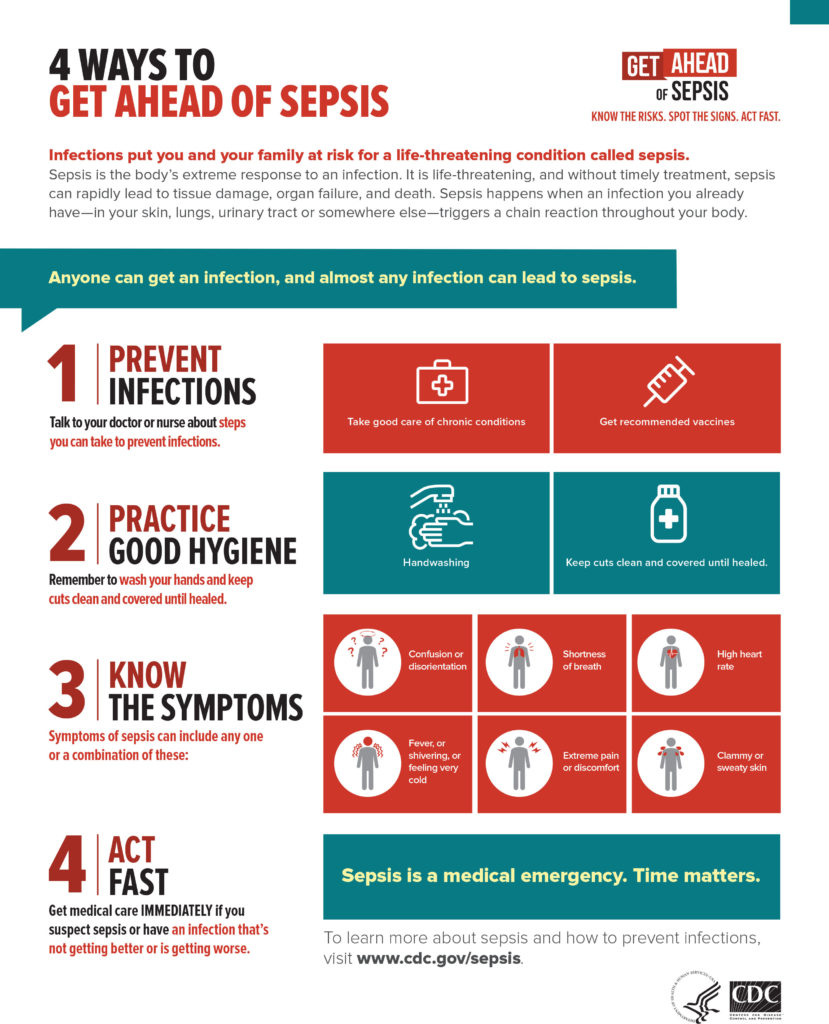Sepsis is a medical condition that can cause death or serious long-term effects. The impact is so great that we’re putting a special focus on sepsis during September, which is Sepsis Awareness Month.
One of the key things you can do to help prevent sepsis is to prevent infections. Not all infections can be prevented, so not all cases of sepsis can be prevented. But by following some basic rules, you can decrease your risk.
It’s also important to know the symptoms of sepsis and to act fast to get medical care if someone has an infection that is getting worse or is not getting better.
Here’s what you need to know:
About sepsis
Sometimes incorrectly called blood poisoning, sepsis is the body’s potentially deadly response to infection or injury. Sepsis and septic shock can result from an infection anywhere in the body, such as pneumonia, influenza, or urinary tract infections. Worldwide, one-third of people who develop sepsis die. Many who do survive are left with life-changing effects, such as post-traumatic stress disorder (PTSD), chronic pain and fatigue, organ dysfunction and/or amputations.
Sepsis can be caused by any type of infection: bacterial, viral, fungal or parasitic. Many infections can be prevented simply by good, consistent hygiene. Others can be prevented through vaccinations.
Vaccinations
Vaccines developed for viruses – such as COVID-19, chicken pox, tetanus and polio – trick your body into thinking it has been infected by the virus, and this helps you build immunity to the illness.
Caring for infections
Every break or opening in your skin can allow germs that could cause an infection to enter your body. For this reason, it’s vital that all wounds be cleaned as quickly as possible and be kept clean. They should also be monitored for signs of an infection.
Cleaning open wounds
- Always wash your hands before touching an open wound. If possible, wear clean disposable gloves.
- If the wound is deep, gaping or has jagged edges and can’t be closed easily, it may need stitches. See your healthcare provider as soon as possible.
- If the wound doesn’t seem to need stitches, rinse it and the surrounding area with clean (not soapy) water. Gently running water over the wound can help remove dirt or debris that may be inside. If you believe there is still debris in the wound, this should be checked by a healthcare provider.
- If desired, apply an antibiotic cream or ointment.
- Cover the wound to protect it from dirt if necessary.
- Watch for signs of infection: redness around the wound, skin around the wound warm to touch, increased pain, and/or discharge from the wound. Consult your physician or nurse practitioner if you suspect you may have an infection.
Blisters
If you have a blister, do not pop it or break it. The blister is a protective barrier and breaking it introduces an opening in your skin. If the blister does break, keep the area clean and monitor for signs of infection.
Treating infections with antibiotics
If you have been diagnosed with a bacterial infection, you will likely be prescribed antibiotics for treatment. Antibiotics kill bacteria or stop them from reproducing.
Some antibiotics work against several types of bacteria, while others are for specific bacteria only. Partly because of overuse and misuse of these medications, some bacteria are becoming resistant to certain antibiotics, making it harder to treat infections. For this reason, it is essential that people take antibiotics only when necessary and exactly as prescribed. For some bacterial infections, doctors prefer to take a watch-and-wait approach before prescribing antibiotics.
Hand washing
Washing our hands is a simple task we do every day, several times a day. For hand washing to be effective, it needs to be done properly.
- To wash your hands, use running water to help wash the debris from your hands.
- Lather your hands well, making sure to rub between each finger and under your nails.
- It’s recommended to wash for at least 20 seconds.
- Dry your hands thoroughly with a clean towel.
If you’re using a hand sanitizer, use the same motions as when using soap and water. Your hands should be dry before touching anything. Hand sanitizers are good for when hands are not visibly dirty, but you know they need to be cleaned.





